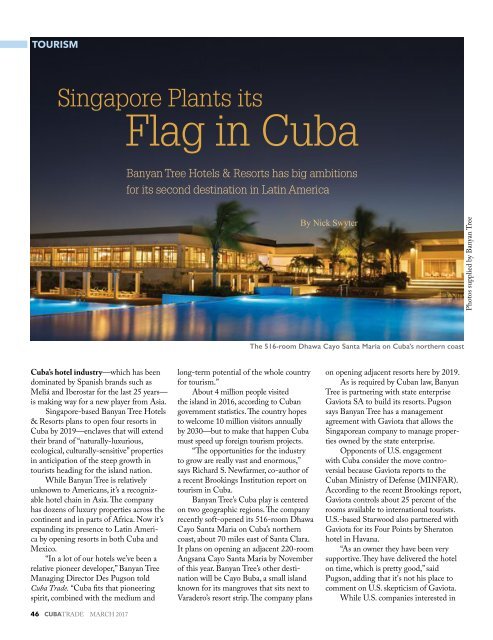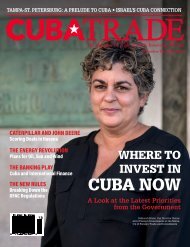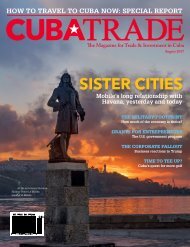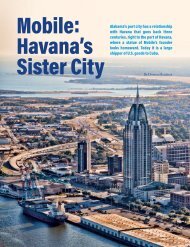Create successful ePaper yourself
Turn your PDF publications into a flip-book with our unique Google optimized e-Paper software.
TOURISM<br />
Singapore Plants its<br />
Flag in Cuba<br />
Banyan Tree Hotels & Resorts has big ambitions<br />
for its second destination in Latin America<br />
By Nick Swyter<br />
Photos supplied by Banyan Tree<br />
The 516-room Dhawa Cayo Santa Maria on Cuba’s northern coast<br />
Cuba’s hotel industry—which has been<br />
dominated by Spanish brands such as<br />
Meliá and Iberostar for the last 25 years—<br />
is making way for a new player from Asia.<br />
Singapore-based Banyan Tree Hotels<br />
& Resorts plans to open four resorts in<br />
Cuba by 2019—enclaves that will extend<br />
their brand of “naturally-luxurious,<br />
ecological, culturally-sensitive” properties<br />
in anticipation of the steep growth in<br />
tourists heading for the island nation.<br />
While Banyan Tree is relatively<br />
unknown to Americans, it’s a recognizable<br />
hotel chain in Asia. The company<br />
has dozens of luxury properties across the<br />
continent and in parts of Africa. Now it’s<br />
expanding its presence to Latin America<br />
by opening resorts in both Cuba and<br />
Mexico.<br />
“In a lot of our hotels we’ve been a<br />
relative pioneer developer,” Banyan Tree<br />
Managing Director Des Pugson told<br />
Cuba Trade. “Cuba fits that pioneering<br />
spirit, combined with the medium and<br />
46 CUBATRADE MARCH 2017<br />
long-term potential of the whole country<br />
for tourism.”<br />
About 4 million people visited<br />
the island in 2016, according to Cuban<br />
government statistics. The country hopes<br />
to welcome 10 million visitors annually<br />
by 2030—but to make that happen Cuba<br />
must speed up foreign tourism projects.<br />
“The opportunities for the industry<br />
to grow are really vast and enormous,”<br />
says Richard S. Newfarmer, co-author of<br />
a recent Brookings Institution report on<br />
tourism in Cuba.<br />
Banyan Tree’s Cuba play is centered<br />
on two geographic regions. The company<br />
recently soft-opened its 516-room Dhawa<br />
Cayo Santa Maria on Cuba’s northern<br />
coast, about 70 miles east of Santa Clara.<br />
It plans on opening an adjacent 220-room<br />
Angsana Cayo Santa Maria by November<br />
of this year. Banyan Tree’s other destination<br />
will be Cayo Buba, a small island<br />
known for its mangroves that sits next to<br />
Varadero’s resort strip. The company plans<br />
on opening adjacent resorts here by 2019.<br />
As is required by Cuban law, Banyan<br />
Tree is partnering with state enterprise<br />
Gaviota SA to build its resorts. Pugson<br />
says Banyan Tree has a management<br />
agreement with Gaviota that allows the<br />
Singaporean company to manage properties<br />
owned by the state enterprise.<br />
Opponents of U.S. engagement<br />
with Cuba consider the move controversial<br />
because Gaviota reports to the<br />
Cuban Ministry of Defense (MINFAR).<br />
According to the recent Brookings report,<br />
Gaviota controls about 25 percent of the<br />
rooms available to international tourists.<br />
U.S.-based Starwood also partnered with<br />
Gaviota for its Four Points by Sheraton<br />
hotel in Havana.<br />
“As an owner they have been very<br />
supportive. They have delivered the hotel<br />
on time, which is pretty good,” said<br />
Pugson, adding that it's not his place to<br />
comment on U.S. skepticism of Gaviota.<br />
While U.S. companies interested in
















